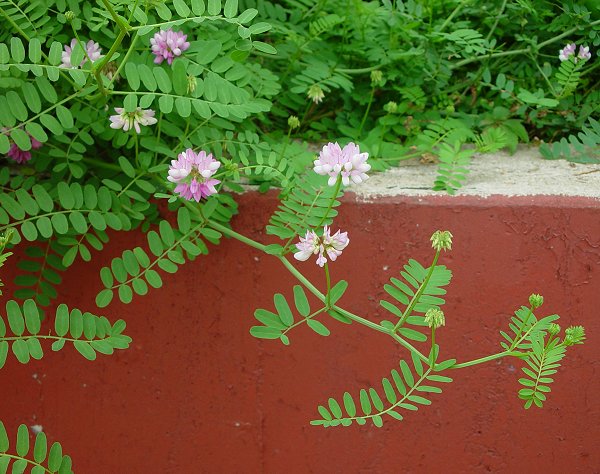Securigera varia (L.) Lassen
Crown Vetch

Introduced
CC = *
CW = 5
MOC = 52
© DETenaglia
Securigera varia (L.) LassenCrown Vetch | |
 |
Introduced CC = * CW = 5 MOC = 52 |
© DETenaglia |
|
Family - Fabaceae/Faboideae Habit - Perennial forb with a woody taproot below a short, branched caudex. Stems - Spreading to loosely ascending, to 1.2 m, branched, multiple from base, often forming loose mats or mounds, angled or ridged, hollow, glabrous or sparsely pubescent with spreading hairs.
Leaves - Alternate, odd-pinnately compound with 9-25 leaflets, sessile or nearly so, the rachis 5-12 cm long. Stipules 1-4 mm long, narrowly lanceolate to narrowly oblong or oblong-triangular, usually reflexed, often with a green central stripe and pale margins, the margins entire or with a few minute teeth. Stipels absent. Leaflets 6-25 mm long, 2.5-9.0 mm wide, the terminal leaflet usually narrowly oblanceolate to oblong-oblanceolate, the lateral leaflets oblong to oblong-oblanceolate, rounded or angled at the base, rounded to truncate or broadly and bluntly pointed at the tip, mucronate, the margins entire, the surfaces glabrous, the upper surface usually with microscopic, dark purple gland-dots (visible only under magnification), the undersurface sometimes purplish-tinged or-mottled, with single prominent midvein. Petiolules to 1.2 mm.
Inflorescence - Axillary, umbellate clusters of 10-20 flowers, the stalk 5-15 cm long, usually with sparse, short, spreading hairs, the tip with 1 bract per flower, these 0.5-1.0 mm long, linear to narrowly oblong or rarely forked apically, darkened at the tips, persistent, each flower with a stalk 3-7 mm long above the bract.
Flowers - Calyces glabrous, the tube 1.0-1.5 mm long, broadly bell-shaped to hemispheric, 2-lipped, the upper 2 lobes fused most of their length, 0.7-1.0 mm long, the unit broadly triangular with a forked tip, the lower 3 lobes similar, 0.5-1.0 mm long, broadly triangular, the margins often thin and pale, glabrous or occasionally minutely and finely hairy, mostly in the sinuses between the lobes. Corollas papilionaceous, pink to purple, often appearing bicolorous, the banner sometimes with a darker, small keel, the wings often lighter (sometimes nearly white), the keel dark purple toward the tip, the banner 9-13 mm long, 5-8 mm wide, the expanded portion broadly ovate, abruptly arched upward from below the midpoint, the wings 9-15 mm long, 4-5 mm wide, oblong, the keel 10-12 mm long, 2-4 mm wide, boat-shaped, fused to the tip, abruptly curved upward near the midpoint, narrowed or tapered to a bluntly pointed tip. Stamens 10, all of similar lengths, 9 of the filaments fused and 1 usually shorter filament free, the fused portion 6-7 mm long, the free portion 3-4 mm long, curved upward, the anthers small, attached at the base, yellow. Ovary 5-7 mm long, the style 5-6 mm long, slender, curved upward, glabrous, the stigma small and terminal.
Fruits - Loments 2-6 cm long, 1.5-2.2 mm wide, narrowly oblong to more commonly linear, short-stalked, tapered to a slender, beaked tip, bluntly 4(5)-angled, only very slightly constricted between the seeds, green to straw-colored or tan, glabrous, breaking apart at maturity into 3-12, 1-seeded segments, these indehiscent or sometimes dehiscing more or less longitudinally with age. Seeds 3-4 mm long, 0.9-1.5 mm wide, more or less cylindric (bluntly rectangular in outline), the surface reddish brown, smooth, dull.
Flowering - May - August. Habitat - Streambanks, pond margins, glades, forest openings, pastures, fields, railroads, roadsides, open disturbed areas. Origin - Native to Eurasia. Lookalikes - None when flowering. Vegetation is similar to that of many other legumes. Other info. - This common species has been widely planted as a roadside ground cover to protect against erosion, before it was realized that it tends to hide, rather than prevent, erosion. It occurs as an introduced species across the continental U.S. The plant is easily recognized by its large numbers of domelike inflorescences which usually have two-toned (pink and white) flowers. It is an attractive plant, but also an aggressive grower which is considered invasive in some areas, and should not be spread. Photographs taken in Eminence, MO., 6-6-03 (DETenaglia); near Labadie, MO, 6-16-2016, and Riverfront Park, Washington, Franklin County, MO, 7-9-2025 (SRTurner). |